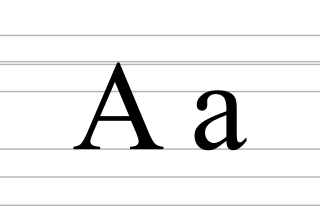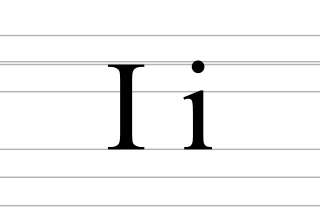
A or a is the first letter and the first vowel letter of the Latin alphabet, used in the modern English alphabet, and others worldwide. Its name in English is a, plural aes.

The Arabic alphabet, or the Arabic abjad, is the Arabic script as specifically codified for writing the Arabic language. It is written from right-to-left in a cursive style, and includes 28 letters, of which most have contextual letterforms. Unlike the modern Latin alphabet, the script has no concept of letter case. The Arabic alphabet is considered an abjad, with only consonants required to be written; due to its optional use of diacritics to notate vowels, it is considered an impure abjad.

F or f is the sixth letter of the Latin alphabet and many modern alphabets influenced by it, including the modern English alphabet and the alphabets of all other modern western European languages. Its name in English is ef, and the plural is efs.

O or o is the fifteenth letter and the fourth vowel letter of the Latin alphabet, used in the modern English alphabet, the alphabets of other western European languages and others worldwide. Its name in English is o, plural oes.

T or t is the twentieth letter of the Latin alphabet, used in the modern English alphabet, the alphabets of other western European languages and others worldwide. Its name in English is tee, plural tees.
In the polytonic orthography of Ancient Greek, the rough breathing character is a diacritical mark used to indicate the presence of an sound before a vowel, diphthong, or after rho. It remained in the polytonic orthography even after the Hellenistic period, when the sound disappeared from the Greek language. In the monotonic orthography of Modern Greek phonology, in use since 1982, it is not used at all.

Ø is a letter used in the Danish, Norwegian, Faroese, and Southern Sámi languages. It is mostly used to represent the mid front rounded vowels, such as and, except for Southern Sámi where it is used as an diphthong.

The Lycian language was the language of the ancient Lycians who occupied the Anatolian region known during the Iron Age as Lycia. Most texts date back to the fifth and fourth century BC. Two languages are known as Lycian: regular Lycian or Lycian A, and Lycian B or Milyan. Lycian became extinct around the beginning of the first century BC, replaced by the Ancient Greek language during the Hellenization of Anatolia. Lycian had its own alphabet, which was closely related to the Greek alphabet but included at least one character borrowed from Carian as well as characters proper to the language. The words were often separated by two points.

The Ugaritic writing system is a cuneiform abjad with syllabic elements used from around either 1400 BCE or 1300 BCE for Ugaritic, an extinct Northwest Semitic language. It was discovered in Ugarit, modern Ras Shamra, Syria, in 1928. It has 30 letters. Other languages, particularly Hurrian, were occasionally written in the Ugaritic script in the area around Ugarit, although not elsewhere.

The Polish alphabet is the script of the Polish language, the basis for the Polish system of orthography. It is based on the Latin alphabet but includes certain letters (9) with diacritics: the acute accent – kreska: ⟨ć, ń, ó, ś, ź⟩; the overdot – kropka: ⟨ż⟩; the tail or ogonek – ⟨ą, ę⟩; and the stroke – ⟨ł⟩. The letters ⟨q⟩, ⟨v⟩, and ⟨x⟩, which are used only in foreign words, are usually absent from the Polish alphabet. Additionally, before the standardization of Polish spelling, ⟨qu⟩ was sometimes used in place of ⟨kw⟩, and ⟨x⟩ in place of ⟨ks⟩.

The Tamil script is an abugida script that is used by Tamils and Tamil speakers in India, Sri Lanka, Malaysia, Singapore and elsewhere to write the Tamil language. It is one of the official scripts of the Indian Republic. Certain minority languages such as Saurashtra, Badaga, Irula and Paniya are also written in the Tamil script.
The Greek alphabet has been used to write the Greek language since the late 9th or early 8th century BC. It was derived from the earlier Phoenician alphabet, and is the earliest known alphabetic script to have developed distinct letters for consonants as well as vowels. In Archaic and early Classical times, the Greek alphabet existed in many local variants, but, by the end of the 4th century BC, the Ionic-based Euclidean alphabet, with 24 letters, ordered from alpha to omega, had become standard throughout the Greek-speaking world and is the version that is still used for Greek writing today.

The Carian language is an extinct language of the Luwic subgroup of the Anatolian branch of the Indo-European language family, spoken by the Carians. The known corpus is small, and the majority comes from Egypt. Circa 170 Carian inscriptions from Egypt are known, whilst only circa 30 are known from Caria itself.

The Letoon trilingual, or Xanthos trilingual, is an inscription in three languages: standard Lycian or Lycian A, Greek, and Aramaic covering the faces of a four-sided stone stele called the Letoon Trilingual Stele, discovered in 1973 during the archeological exploration of the Letoon temple complex, near Xanthos, ancient Lycia, in present-day Turkey. It was created when Lycia was under the sway of the Persian Achaemenid Empire. The inscription is a public record of a decree authorizing the establishment of a cult, with references to the deities, and provisions for officers in the new cult. The Lycian requires 41 lines; the Greek, 35 and the Aramaic, 27. They are not word-for-word translations, but each contains some information not present in the others. The Aramaic is somewhat condensed.

L or l is the twelfth letter of the Latin alphabet, used in the modern English alphabet, the alphabets of other western European languages and others worldwide. Its name in English is el, plural els.

The Carian alphabets are a number of regional scripts used to write the Carian language of western Anatolia. They consisted of some 30 alphabetic letters, with several geographic variants in Caria and a homogeneous variant attested from the Nile delta, where Carian mercenaries fought for the Egyptian pharaohs. They were written left-to-right in Caria and right-to-left in Egypt.

Lydian script was used to write the Lydian language. Like other scripts of Anatolia in the Iron Age, the Lydian alphabet is based on the Phoenician alphabet. It is related to the East Greek alphabet, but it has unique features.
Greek orthography has used a variety of diacritics starting in the Hellenistic period. The more complex polytonic orthography, which includes five diacritics, notates Ancient Greek phonology. The simpler monotonic orthography, introduced in 1982, corresponds to Modern Greek phonology, and requires only two diacritics.

I or i is the ninth letter and the third vowel letter of the Latin alphabet, used in the modern English alphabet, the alphabets of other western European languages and others worldwide. Its name in English is i, plural ies.















